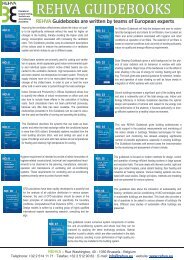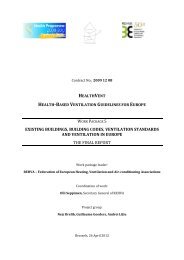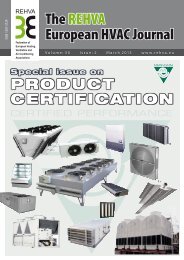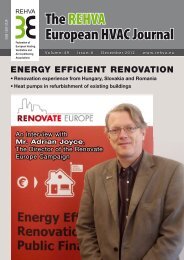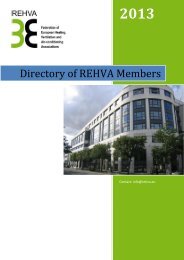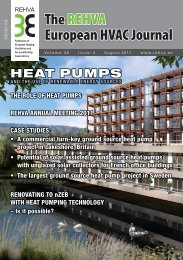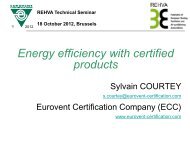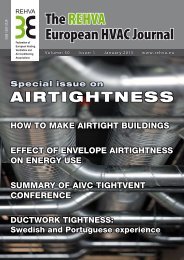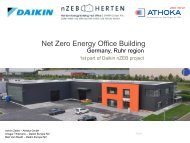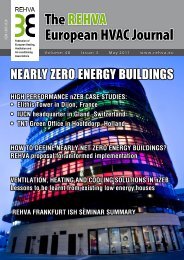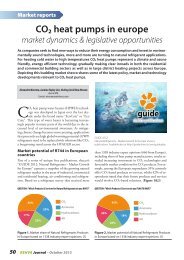Improved energy efficiency of air cooled chillers (PDF 387 kB) - rehva
Improved energy efficiency of air cooled chillers (PDF 387 kB) - rehva
Improved energy efficiency of air cooled chillers (PDF 387 kB) - rehva
Create successful ePaper yourself
Turn your PDF publications into a flip-book with our unique Google optimized e-Paper software.
Articles<br />
COP - EER<br />
Power [kW]<br />
65<br />
55<br />
45<br />
• Reduced mechanical<br />
Compressor<br />
compressors<br />
absorbed<br />
wear,<br />
power<br />
as the<br />
screw will rotate for most <strong>of</strong> year with reduced<br />
r.p.m. (higher MTBF).<br />
• Inverter technology with screw compressor<br />
variable Vi, using automatic control <strong>of</strong> Vi the<br />
performances <strong>of</strong> chiller increase.<br />
Performance <strong>of</strong> a Hitema chiller with<br />
compressors driven by inverter<br />
35<br />
Power [kW]<br />
Figure 1. Comparison with <strong>of</strong> slide performance valve with inverter <strong>of</strong> <strong>chillers</strong>.<br />
Figure 1 illustrates the first important point showing<br />
lower absorbed power <strong>of</strong> the screw compressor when<br />
installed with an inverter, compared against a standard<br />
screw compressor with a slide valve. Chiller with inverter<br />
screw compressors are more versatile and highly<br />
efficient specialists used in <strong>chillers</strong> for <strong>air</strong> conditioning<br />
systems and industrial process cooling.<br />
chiller and the total power consumption <strong>of</strong> the refrigeration<br />
unit (compressors + fans). If the cooling load decreases<br />
whilst the ambient temperature decreases, then<br />
the absorbed power <strong>of</strong> chiller decreases much more rapidly<br />
than the reduction in cooling capacity in a non-linear<br />
relationship.<br />
These COP and EER values are very competitive with<br />
other available technologies (eg, centrifugal compressors)<br />
and COP values with inverter screw compressors<br />
can attain >8 and EER >7. This chart above refers to an<br />
<strong>air</strong> <strong>cooled</strong> chiller with R-134A refrigerant, with inlet water<br />
temperature <strong>of</strong> 12°C and outlet water temperature<br />
<strong>of</strong> 7°C. The graph illustrates the massively beneficial effect<br />
on the <strong>efficiency</strong> <strong>of</strong> the chiller unit as the ambient<br />
<strong>air</strong> temperature and the load on the chiller reduce from<br />
100% load in a 35°C ambient (worse case), to a situation<br />
whereby the load on the chiller is 50% and the ambient<br />
temperature is 15°C. As can be clearly observed,<br />
the EER for the unit at 50% load in a 15°C ambient is<br />
over double (~7) the value compared to when at 100%<br />
load in a 35°C ambient temperature (~3). The thermal<br />
performances indicated demonstrate that this unit easily<br />
qualifies for Class A <strong>efficiency</strong> categorisation.<br />
It is clearly important to know the ambient temperature,<br />
the water temperature and the maximum load during<br />
the year (month by month) in order to assess the real<br />
operating <strong>efficiency</strong> <strong>of</strong> chiller unit.<br />
With a slide valve the gas flow control is less accurate<br />
than the inverter controlled counterpart. With a standard<br />
compressor the capacity steps are 7 static and prefixed 7<br />
December<br />
(eg, 100%, 75%, 50% and 25%). With the inverter solution,<br />
the screw revolution decreases 6.5<br />
6.5<br />
December<br />
9<br />
January<br />
proportionally<br />
January 6<br />
November<br />
8 and the gas flow is modulated linearly. 6<br />
5.5<br />
March November<br />
7<br />
9<br />
5.5<br />
5<br />
March<br />
6<br />
8<br />
COP<br />
4.5<br />
October<br />
5<br />
EER<br />
5<br />
EER<br />
4<br />
July<br />
7<br />
3.5 October<br />
4<br />
4.5<br />
6<br />
COP<br />
3<br />
3<br />
4<br />
July<br />
5<br />
EER<br />
0 2 4 6 8<br />
2<br />
4<br />
3.5<br />
Month<br />
40 60 80 100<br />
3<br />
3<br />
Load [%]<br />
Figure 3. EER value <strong>of</strong> a chiller without free cooling.<br />
2<br />
0<br />
<br />
2 4 6 8<br />
40 60 80 100<br />
Figure Month 3 shows the EER value trend <strong>of</strong> a chiller without<br />
Load [%]<br />
free cooling when operating with a water outlet temperature<br />
<strong>of</strong> <br />
<br />
Figure 2. Performance for <strong>air</strong> <strong>cooled</strong> chiller.<br />
5°C.<br />
COP - EER<br />
65<br />
Compressor absorbed power<br />
25<br />
Compressor absorbed power<br />
55<br />
40 50 60 70 80 90 100 110<br />
45<br />
Load [%]<br />
35<br />
with slide valve with inverter<br />
25<br />
40 50 60 70 80 90 100 110<br />
Load [%]<br />
EER<br />
<br />
EER<br />
EER<br />
<br />
Figure 2 illustrates the real data performance for <strong>air</strong><br />
<strong>cooled</strong> chiller. The COP is the ratio between cooling<br />
capacity and the compressor absorbed power input. The<br />
EER is the relationship between the cooling capacity <strong>of</strong><br />
This chiller is designed for 680 kW at full load. During<br />
the warmer months <strong>of</strong> the season (June-August) the required<br />
load is 100%, whilst during the colder period<br />
(November-March), when ambient temperature is much<br />
REHVA Journal – January 2013 51



